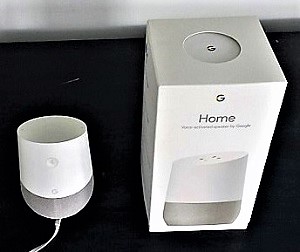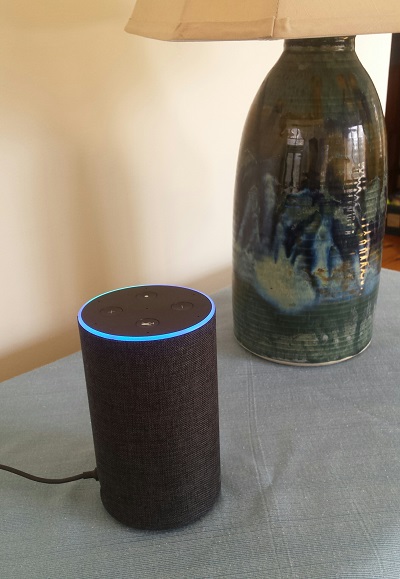In a very short period of time, a whole new genre of devices has evolved called, "smart speakers." It started with the Amazon Echo a couple of years ago, spread to the Google Home, and now, there is the Apple Home Pod, the Sonos One, and more. The major differences are in the sound quality, the smart assistant responding to the user’s verbal questions, and the price.
Google Home and Amazon Echo

Let’s keep it simple here and focus on the market leaders, the Amazon Echo and Google Home. For readers new to these devices, the smart speaker is a stand-alone speaker that connects to the WiFi in the home, has very few controls on the surface of the device, and primarily is used by speaking to it. For example, you might alert your Echo by first using the wake word "Alexa," followed by a question: "What’s the weather forecast this week in Maine?" Almost instantaneously, the Echo would speak the weather forecast. The Google Home works in much the same way with a wake phrase of "Hey Google."
Both devices require an initial setup using a computer, tablet, or smartphone, but after that, there doesn’t need to be much additional use of the computer for day-to-day use. For this reason, after the initial setup, these devices are ideal for someone with limited computer knowledge. Additionally, because most models don’t have a screen, all the interaction with the device is verbal.
Amazon Skills Versus Google Intuition

Both devices have evolved quickly in a short period of time, adding features, and simplifying their use. For example, the Amazon Echo uses what it calls "skills" to enable certain functions. In order to listen to streaming radio stations, you might have to first enable a skill on the Alexa app, using the computer or tablet app. Once enabled, you need to recall a specific phrase to make an app work. An example of this might be using the skill called "Simple Radio," which can play thousands of radio stations. Once the skill is enabled, the user might find a station by saying, "Alexa, ask ‘Simple Radio’ to play BBC music." As a result, for skills that are used every day, these phrases are easily remembered, but for those used less frequently, recalling these phrases might be more difficult! To some degree, it seems as though both devices have become a bit more intuitive overall and understand user commands that are less precise.
The Google Home’s approach to applications or skills is somewhat different. During the setup process, if you were interested in streaming music, you might select one of the services Google integrates with like Spotify, Pandora, Google Music, etc. These are listed in "Settings" under "Music." As a rule, there are far fewer options than what is available on the Echo, however, the Google Home seems more intuitive by offering suggestions or opening an application by voice. An example of this was asking Google Home the following, "Hey Google, can you read a verse from the Bible?" The reply was, "For that, you might want to try ‘YouVersion.’ Want to give it a try?" Answering, "Yes" opened the app, and in a short time, I could specify specific books, chapters, or verses. The Alexa app lists over 70 skills that read Bible verses. Any of these can be enabled from the Alexa app on a tablet or smartphone, but none can be added by voice as the Google Home did. While there was less choice in this particular example with the Google Home, it was easier to add by voice.
Making Phone Calls at Last!
One of the biggest breakthroughs, for both devices, happened last fall with the ability to make phone calls using the Google Home or Amazon Echo. The Amazon Echo had the ability to call another person with an Amazon Echo from early on in its development, as long as that person was listed in a user’s contacts. Now, however, a phone call can be made from either device by simply saying, "Hey Google (or Alexa), call…," and providing the number to call. If, for example, you wanted to call customer service at the American Printing House for the Blind (APH) using the Echo, you would say, "Alexa, call 800-223-1839," and the call would be placed over the WiFi Internet.
While there are many similarities between the Google Home and Amazon Echo, making phone calls is just one of the areas where there are some subtle but dramatic differences between the two. Both devices make it easy to find the number of local businesses. To get a phone number for the Maine nonprofit agency providing vision rehabilitation services, either device will provide a phone number when asked, "Alexa (Hey Google), what’s the phone number for The Iris Network in Portland Maine." Only the Google Home device can take the next step to call the number, eliminating the need on the Amazon Echo to record the number first. In fact, the Google Home can make a phone call just by using the command, "Hey Google, call the Iris Network in Portland Maine." The Echo can look up the number and make the call if you speak the number but is not yet able to call by requesting the business name only the way the Google Home does.
Is Texting Next?
In addition to making phone calls, the next big hurdle is the ability to send and receive text messages. The most recent update to the Amazon Echo permits users to link a phone for text messaging to the account. Like the earlier version of calling with the Echo, users have been able to send messages to other people with an Amazon Echo for some time. The recent update now allows a text message to be sent from the Echo to a phone, regardless of whether this person has an Echo or not. Just as with making phone calls, the command for texting requires using the phone number or the contact name if listed in your contacts. For example, the command might be, "Alexa, send a text message to Uncle Albert," if he is listed in your contacts, or just provide a phone number where the text is being sent. As of this blog post, the Google Home does not send text messages yet, but you can bet this is high on their priority list of upcoming features!
The drawback, right now, for texting with the Echo is that for those users who are not also smartphone or tablet users, there is no way to receive and listen to a text message, and like with phone calls, if you are texting or making calls to an automated service that requires entering numbers after the call, there is no way to input those numbers. So if the primary goal is to enable a user to text by voice, the Amazon Echo is not quite there yet, but getting closer. Of course, if sending and receiving texts by voice is a goal, Siri can do this on the iPad, iPhone, and iPod Touch, and the "OK Google" app can do this on both Android and iOS devices, but that’s another article!
Alexa,"Read My Book!"
Other recent improvements include expanded book reading, primarily for the Amazon Echo. The Google Home will play books from its own service, Google Play, which is extensive, but trails the competition—Amazon and Audible. The Amazon Echo was able to play Audible audiobooks from very near the beginning of service and recently added the ability to play narrated Amazon books as well. Audible is a service that charges a monthly fee, which entitles users to a certain number of credits, with which to use to purchase audiobooks. Books may be downloaded and played on a computer, tablet, smartphone, Victor Reader Stream—virtually anything that will play the native MP3 file format. On the Echo, these books are streamed to the Echo and can be paused, fast-forwarded, and rewound using a voice command. The last reading location is recorded so the next time a user says, "Alexa, read my book," reading begins where it left off. Both Kindle narrated books and Amazon book titles are stored in the cloud, meaning any of the books in your library are available from the Echo.
Books are certainly not the only way to read using the smart speakers. The Echo offers two skills, Audio Reader and Sun Sounds of Arizona related to radio reading services for the blind. Radio Reading Services historically have been regional services comprised of volunteers reading the local newspaper and broadcasting live on local radio stations specifically for listeners with a print disability. Both skills, of course, must be enabled from the Alexa app, but once enable, simply saying, "Alexa, open Audio Reader (or Sun Sounds)," begins the streaming live broadcast. Although the Google Home does not have specific skills for radio reading services like the Echo, if selected during setup, the Google Home will stream many live broadcasts from services like TuneIn Radio. As a result, some of the radio reading services now streaming on TuneIn, like Triangle Radio Reading Service and Mountain Area Radio Reading Service will play live, using the command, "Hey Google (Alexa), play Triangle Radio Reading Service on TuneIn." TuneIn is certainly not limited to radio reading services for content; many podcasts like Cool Blind Tech can also be streamed on the Echo and Google Home using TuneIn or other radio services.
Lower Prices
Before the holiday season, Amazon’s most recent second Generation Echo debuted with a significant price drop at $99. The second generation Echo is somewhat smaller, seems to have a better quality speaker, and is almost half the cost of the original Echo! A smaller version, the Echo Dot, is available for $49 and does everything the larger version does but lacks the better speaker. There are several more versions and configurations available from Amazon, but these are the most popular.
Google Home is $129 for the full-size model and offers a mini version for $49. Like the Echo, the mini version lacks the larger speaker but performs all of the functions the larger version does.
It is no surprise the smart speakers are showing up everywhere! Once set up, they make a simple way to access a great deal of information and services that used to be only available to those who were able to use a computer or smart device. They are so convenient that even if you are a savvy computer user, you will quickly bond with the convenience of using a quick verbal command to answer a question, read a book, or play some music. With the recent ability to make a phone call using either the Amazon Echo of Google Home completely by voice, each has demonstrated what a handy household device they can be. Add this to the other features like reading a book, sending a text, listening to a newspaper on a radio reading service, plus the many other entertainment and information services available, either device makes a great addition to home or office.